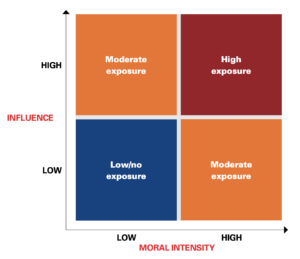Yesterday, I began a series considering how a Chief Compliance Officer (CCO) and corporate compliance function can help lead a company’s human rights initiatives against such scourges as human trafficking and modern slavery based upon a recent MIT Sloan Management Review article, entitled “Does Your Business Need a Human Rights Strategy?,” by authors N. Craig Smith, Markus Scholz and Jane Williams. In this piece, they took a solid look at both the risk side of this equation as well developing a corporate strategy to deal with the issue. Yesterday we looked at a framework to assess the human rights issues your organization may face in doing business across the globe. Today, we consider how to use that assessment in crafting a human rights strategy.
Three Key Decisions
The authors believe there are three key decisions an organization must make to determine a strategy and then begin to execute on that strategy.
Decision 1: Exit, Voice, or Silence?
At the most basic level the initial decision a company must make is whether to get involved. The authors believe, “business leaders must decide whether the issue requires further attention and, possibly, action. Is it serious enough to warrant divesting operations and/or possibly leaving the country? If not, what other options are available?” The caution that this calculus is “not always straightforward, nor is flight always the most appropriate action: Pulling out of a country can not only seriously impact a business’s bottom line but also harm the communities in which it operates, such as by eliminating local jobs or ending prosocial initiatives the company has taken.” However, in the event that an organization “makes the choice to continue operating and to work to address systemic human rights abuses within its environment, it needs to develop a nuanced strategy and be very deliberate about how and with whom it interacts.”
Decision 2: A Collective or Individual Approach?
The authors believe that if a company “chooses to stay and take action, it must decide whether the issue is best addressed by the company individually or should be undertaken collectively with other organizations or stakeholders.” At times such an individual approach can be effective if the company is large enough to have influence and can act with expedience. Conversely, smaller organizations may team up with other companies or even other stakeholders.
For this latter situation, the authors pointed to “the reaction of companies in the garment sector after the 2012 Rana Plaza tragedy in Bangladesh offers an example of collective action… Companies in the sector worked together to introduce the Accord on Fire and Building Safety in Bangladesh, an independent, legally binding agreement formed among global brands, retailers, and trade unions. Since the accord’s creation, engineers have inspected more than 2,000 garment factories, addressed more than 150,000 safety hazards, and helped set up safety training programs that have educated more than 1.4 million workers in proper workplace safety practices.”
Decision 3: Which Actions and Tactics Should Be Chosen?
Next is the move into execution. Should an organization “take direct action to stop human rights violations or whether more can be done by indirectly influencing the institutional settings in which they operate.” In the Rani Plaza response, the indirect strategy proved effective but “if ready-made garment brands had become aware that a particular factory presented an extreme and urgent threat to life — they may have instead chosen to take direct action, such as putting pressure on politicians or legal enforcement agencies to close or force repairs to the building.”
Tactics
The next set of decisions is around tactics. Should they be direct or indirect? In the direct tactics camp, the authors provide three examples. (1) Companies can provide information about human rights abuses. (2) Organizations can decide whom to provide financial aid to in the fight for human rights. (3) Businesses can engage in certain activities or decline to participate in commercial events. Under indirect tactics the authors also list three examples, including: (a) Companies can work to strengthen and otherwise support NGO or other similar organizations fighting human rights abuses. (b) Businesses can sign up for international initiatives such the UN Compact on climate change or NGO efforts to fight human trafficking and modern slavery, such as put forward by the Global Fund to End Modern Slavery. (c) Organizations can work to develop, solely or in conjunction with others “new standards that supplement hard law. By acting collectively or alongside other multistakeholder initiatives, organizations can individually create rules of the game that define guardrails for corporate behavior.”
However sometimes, even with the most robust risk analysis and a defined strategy, a company makes the decision it must leave. As the authors noted, “There may be times when, in balancing the tension between the moral and business imperative, leaders feel that the best — or only — choice is for a company to leave, be it a problematic supply chain, a market where its products are implicated in human rights abuses, or even an entire country. The decision then will be whether to take the high road and exit with fanfare to publicly signal.” This happened with many energy companies and Venezuela in the last decade. Just last week, NPR reported, “Total Energies and Chevron, two of the world’s largest energy companies, said Friday they were stopping all operations in Myanmar, citing rampant human rights abuses and deteriorating rule of law since the country’s military overthrew the elected government in February.”
The bottom line is that doing nothing is no longer an option. As human trafficking and modern slavery become more publicized, international companies must work to assess their risks and manage those risks through a human rights strategy. The authors end by stating, “Companies are increasingly expected to assume political responsibilities. Doing nothing when there is an arsenal of options available might easily be interpreted as — at minimum — silent complicity with human rights violations.” Once again compliance needs to lead the way for every business on this issue.






